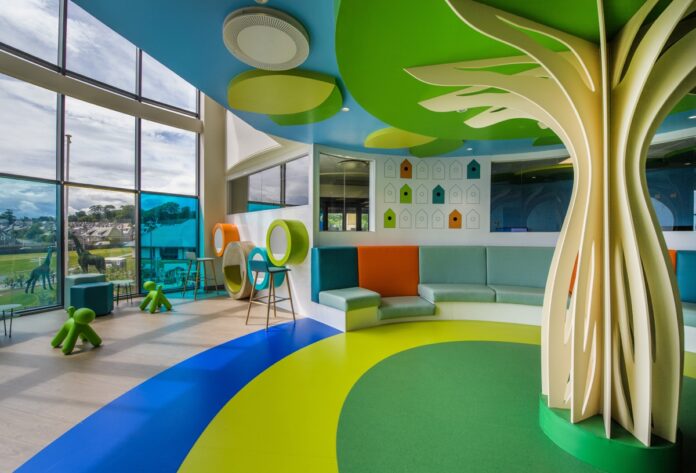Auhtor: Tori Rodriguez
Published on September 5, 2024
“Decision-making regarding the use of specific colors in health care spaces appears to be largely based on general psychological research and well-established color theory used in art and design. However, the results of several recent studies suggest that the strategic use of color may enhance the patient experience in health care settings.
For example, a study published in 2023 in the Health Environments Research and Design Journal (HERD) examined the utility of strategic color changes to improve wayfinding in the redesign of an emergency department in Sweden.2 In this study, common patient areas were painted solid neutral colors (gray/beige), while patient-restricted areas were painted red or other colors that contrasted with the neutral patient areas and floors were given a darker shade near the walls to highlight the boundaries of rooms. Based on participant responses on self-report questionnaires that were created and validated by the investigators, the new design was associated with an increased perception of awareness, orientation, and safety among patients and family members compared to the previous design.2“
…
“Despite its success in commercial environments, the deliberate use of color in health care remains surprisingly limited, offering a unique opportunity to harness these principles for more empathetic and effective medical spaces. Although additional research using rigorous methodology is needed before color strategies in health care spaces can be considered evidence-based, the aesthetic and practical effects of the intentional use of color remain important considerations in these settings. By strategically incorporating color psychology into health care settings, designers can potentially increase patient comfort, reduce anxiety, and improve overall satisfaction.
The power of color psychology has been a relatively untapped resource for most health care organizations due to the lack of knowledge of its efficacy in a strictly scientific modality. However, even this year, an increasing number of spaces are becoming aware of and starting to strategically use color in their facilities. The ability to link specific colors – and even the undertones of certain colors – to clearly communicate and influence a patient’s physical and emotional states is hugely significant.
We typically see the most intentional use of color in children’s health care settings with an assortment of rainbow colors. This is to help children feel more comfortable and to elicit emotions of joy, growth, and positivity. Some great examples of this approach are the New Lady Cilento Children’s Hospital and the Bendigo Hospital in Australia.
The biggest issue with the use of color in health care is intentionality. For example, because red may increase heart rate, blood pressure, and pupil dilation, this is a color to avoid in most health care settings, as it may cause higher levels of stress, especially in cases of physical, emotional, or mental trauma.7-9 This is why the color red has been tied to emergency services, especially since red is the color we first recognize and respond to with attention and alertness10” (Rodriguez, 2024).
This article discusses the active effect that color has in the health care field. Not only the choice of color can affect people experiences but also tones, saturation, associations and orientations. Some big points I took away from it that could be useful to my focus concern the specific colors to avoid and how intentional designing with color can be. I will be designing a product within the medical field. The color choice needs to be intentional to the needs of the product. As the article mentions many waiting rooms use blue because it is calming and reducing heart rate while red increasing heart rate and blood pressure. A study done with lighter colored recovery rooms and minimal to no colored recovery rooms produced a significant increase in post-op quality of life in the lighter colored rooms. With such clear evidence that color is impactful, it would be ignorant to design my own medical device without the meaningful considerations and decisions of color.
Reference
Rodriguez , T. (2024, September 5). Color in Health Care: How Mindful Design Can Improve Clinical Spaces. Clinical Pain Advisor. https://www.clinicalpainadvisor.com/features/color-in-health-care-design-spaces/




